Related Research Articles

Etiella zinckenella, the pulse pod borer moth, is a moth of the family Pyralidae. It is found in southern and eastern Europe and in the tropics and subtropics of Africa and Asia. They have also been introduced to North America and Australia. It is usually a minor pest for many legumes, but can be a serious pest.
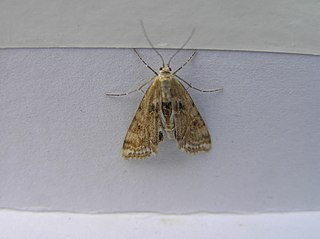
Cataclysta lemnata, the small china-mark, is a moth species of the family Crambidae. It is found in Europe, Morocco and Iran.
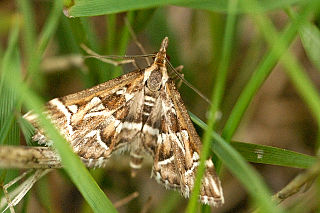
Diasemia reticularis is a species of moth of the family Crambidae. It is typically found in the tropics, but may range into Europe as far north as the North Sea region because of its migratory nature.
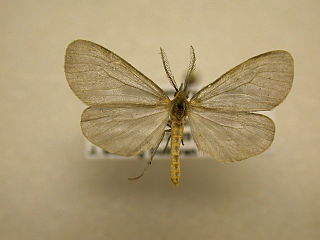
Pagara is a monotypic moth genus in the family Erebidae. Its only species, Pagara simplex, the mouse-colored lichen moth, is found in North America, where it has been recorded from Alabama, Arkansas, Florida, Georgia, Illinois, Indiana, Iowa, Kansas, Kentucky, Maryland, Mississippi, New Hampshire, North Carolina, Ohio, Oklahoma, South Carolina and Tennessee. Both the genus and species were described by Francis Walker in 1856.
Geshna is a monotypic moth genus of the family Crambidae described by Harrison Gray Dyar Jr. in 1906. It contains only one species, Geshna cannalis, the lesser canna leafroller, described by Altus Lacy Quaintance in 1898. It is found in North America, where it has been recorded from Florida, Mississippi, South Carolina, North Carolina and Tennessee. It has also been recorded from Costa Rica and Cuba.

Schinia nubila, the camphorweed flower moth or brown flower moth, is a moth of the family Noctuidae. The species was first described by Herman Strecker in 1876. It is found from the US states of Oklahoma to New Jersey, south to Florida and Texas. Its range is expanding in the northeast. Furthermore, recorded from Colorado, Kansas, Oklahoma, Arkansas, North Carolina, South Carolina and Maryland.

Macaria abydata, commonly known as the dot-lined angle, is a moth of the family Geometridae. It is native from northern Argentina to the Caribbean and southern United States. It has been introduced to the Pacific and has spread rapidly since. The first introduction occurred in Hawaii in 1970. Further spread occurred as follows:
Ponometia semiflava, the half-yellow or yellow-cloaked midget, is a moth of the family Noctuidae. The species was first described by Achille Guenée in 1852. It is found in North America from New York and New England to Florida, west to Arizona, north to British Columbia and Manitoba.

Acontia cretata, the chalky bird dropping moth, is a moth of the family Noctuidae. The species was first described by Augustus Radcliffe Grote and Coleman Townsend Robinson in 1870. It is found from the US states of California to Texas and Oklahoma, north to Colorado and Utah.

Ptichodis herbarum, the common ptichodis moth, is a moth in the family Erebidae. It is found in the United States. It has also been recorded from Jamaica.

Idaea eugeniata is a moth in the family Geometridae. It is found in Italy, France, Andorra, Spain, Portugal and North Africa.

Phtheochroa implicata, the plain conch, is a species of moth of the family Tortricidae. It is found in China, Iran, Japan, Mongolia, Russia and most of Europe. It has also been recorded from North America. The habitat consists of damp areas and woodland edges.
Archips fuscocupreanus, the exotic leafroller moth or apple tortrix, is a species of moth of the family Tortricidae. It is found in China, South Korea, Japan and Russia. It is an introduced species in the north-eastern United States, where it has been recorded from Connecticut, Massachusetts, New Jersey, New York and Rhode Island. It has also been recorded from Washington.

Diedra cockerellana, Cockerell's moth, is a species of moth of the family Tortricidae. It is found in North America, where it has been recorded from California, Colorado, Illinois, Indiana, Iowa, New Mexico, Ontario, Utah and Wisconsin.
Hahncappsia neobliteralis is a moth in the family Crambidae. It was described by Hahn William Capps in 1967. It is found in North America, where it has been recorded from Indiana, Iowa, Maryland, Mississippi, New Jersey, North Carolina, Ohio, Pennsylvania, Quebec, Tennessee, Washington D.C. and West Virginia.

Digrammia continuata, the curve-lined angle, is a species of moth of the family Geometridae. It is found in North America, where it has been recorded from New Brunswick to Florida, west to California and north to Manitoba.

Ponometia candefacta, the olive-shaded bird-dropping moth, is a moth of the family Noctuidae. It is found in North America, where it has been recorded from the northern United States to southern Mexico. It has been introduced to Russia as a biological control agent. The habitat consists of dry, weedy, disturbed areas at low elevations.
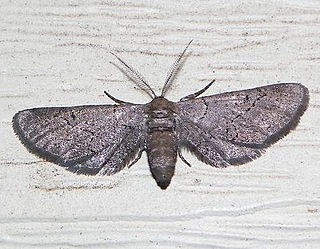
Exelis pyrolaria, the fine-lined gray moth or plumose gray moth, is a species of moth in the family Geometridae. It is found in North America, where it has been recorded east of the Mississippi River and south of Illinois and the District of Columbia.
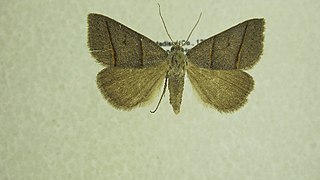
Ptichodis bistrigata, the southern ptichodis moth, is a moth of the family Erebidae. It is found in North America, where it has been recorded from Texas to Florida, north to Massachusetts and west to Wisconsin.
Anacampsis innocuella, the dark-headed aspen leafroller moth, is a moth of the family Gelechiidae. It was described by Philipp Christoph Zeller in 1873. It is found in North America, where it has been recorded from Alabama, British Columbia, Illinois, Indiana, Maine, Mississippi, New York, Nova Scotia, Ohio, Oklahoma, Ontario, Quebec and Vermont.
References
- ↑ "GlobIZ search". Global Information System on Pyraloidea. Retrieved 2014-07-15.
- ↑ Moth Photographers Group at Mississippi State University
- ↑ Proceedings of the United States National Museum 120 (3561)
| This Pyraustinae-related article is a stub. You can help Wikipedia by expanding it. |